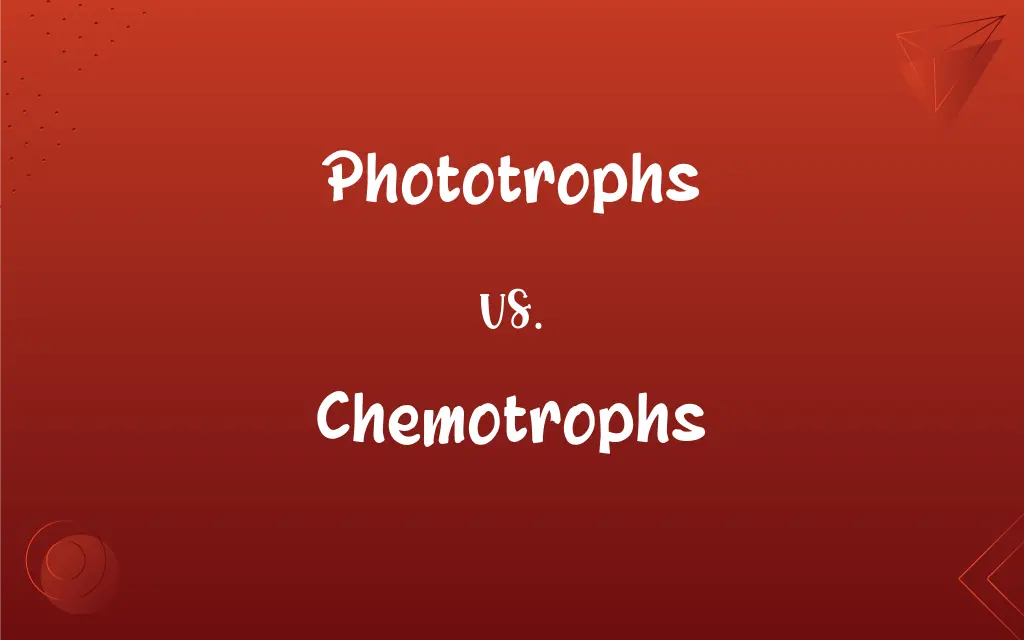Phototrophs vs. Chemotrophs: What's the Difference?
Edited by Janet White || By Harlon Moss || Updated on October 17, 2023
Phototrophs harness light for energy; chemotrophs obtain energy from chemicals. Both represent distinct energy acquisition methods in organisms.

Key Differences
Phototrophs are organisms that utilize light as their primary source of energy to produce ATP. Chemotrophs, on the other hand, derive their energy from the oxidation of chemical compounds.
Phototrophs largely depend on sunlight, relying on photosynthetic pigments like chlorophyll to capture light energy. In contrast, chemotrophs rely on specific chemical reactions, often involving inorganic or organic molecules, to generate energy.
The energy acquisition method of phototrophs usually involves the conversion of light energy into chemical energy in the form of ATP. Chemotrophs, conversely, involve electron transfer processes, where electrons are transferred from a donor molecule to an acceptor molecule, facilitating ATP production.
Phototrophic organisms include plants, algae, and some bacteria, which use the process of photosynthesis. Chemotrophs include many bacteria and archaea, which may use processes like fermentation or respiration to derive energy.
Both phototrophs and chemotrophs are essential in the biosphere. While phototrophs contribute to the conversion of solar energy into a form usable by living organisms, chemotrophs play a vital role in recycling nutrients and participating in various biogeochemical cycles.
ADVERTISEMENT
Comparison Chart
Energy Source
Derive energy from light.
Obtain energy from chemicals.
Typical Organisms
Plants, algae, some bacteria.
Many bacteria and archaea.
Key Processes
Photosynthesis.
Fermentation, respiration.
Dependency
Dependent on light-absorbing pigments.
Rely on chemical reactions involving donor and acceptor molecules.
Role in the Biosphere
Convert solar energy to a form usable by organisms.
Recycle nutrients and participate in biogeochemical cycles.
ADVERTISEMENT
Phototrophs and Chemotrophs Definitions
Phototrophs
Organisms that utilize light for energy production.
Plants are classic examples of phototrophs, converting sunlight into energy.
Chemotrophs
Can utilize inorganic or organic molecules for energy.
Certain chemotrophs oxidize ammonia to nitrate for energy.
Phototrophs
Primary contributors to photosynthesis.
Phototrophs play a significant role in oxygenating our planet.
Chemotrophs
Independent of light for energy production.
Deep-sea vents host chemotrophs that never see sunlight.
Phototrophs
Light-dependent energy producers.
The presence of phototrophs in a habitat indicates light accessibility.
Chemotrophs
Central players in various biogeochemical cycles.
Chemotrophs are pivotal in nitrogen and sulfur cycling in ecosystems.
Phototrophs
Entities relying on photosynthetic pigments.
Cyanobacteria contain chlorophyll, identifying them as phototrophs.
Chemotrophs
Organisms deriving energy from chemical compounds.
Many bacteria thriving in extreme environments are chemotrophs.
Phototrophs
Converters of light energy to chemical energy.
Through photosynthesis, phototrophs produce sugars from sunlight.
Chemotrophs
Reliant on electron transfer processes.
Chemotrophs like certain sulfur bacteria oxidize inorganic molecules for energy.
Phototrophs
An organism that is capable of using light energy to synthesize sugars and other organic molecules from carbon dioxide. Green plants, algae, and cyanobacteria are phototrophs. Also called photoautotroph.
Chemotrophs
Plural of chemotroph
Phototrophs
Plural of phototroph
FAQs
What are phototrophs?
Phototrophs are organisms that derive energy from light through photosynthesis.
How do chemotrophs produce energy?
Chemotrophs produce energy by oxidizing chemical compounds.
Which organisms are typically phototrophs?
Plants, algae, and some bacteria are typical phototrophs.
Can chemotrophs utilize light for energy?
No, chemotrophs rely exclusively on chemicals for energy and do not utilize light.
Are phototrophs found in dark environments?
No, phototrophs require light for energy and aren't typically found in dark environments.
Can chemotrophs thrive in the absence of light?
Yes, chemotrophs can thrive without light by utilizing chemical reactions for energy.
What type of environment would favor chemotrophs over phototrophs?
Dark environments or places with limited light access, like deep-sea vents, would favor chemotrophs.
Are all plants phototrophs?
Yes, all plants are phototrophs as they use light for energy production.
Why are chemotrophs essential in certain extreme environments?
Chemotrophs can extract energy from chemicals in environments where light isn't accessible, like deep-sea vents.
What role do chemotrophs play in nutrient cycling?
Chemotrophs are involved in various biogeochemical cycles, recycling nutrients like nitrogen and sulfur.
What's the primary energy currency for both phototrophs and chemotrophs?
Both phototrophs and chemotrophs produce ATP as the primary energy currency.
Are there chemotrophs that use organic molecules for energy?
Yes, some chemotrophs, known as chemoorganotrophs, use organic molecules for energy.
Do phototrophs release oxygen?
Yes, oxygenic phototrophs release oxygen as a byproduct of photosynthesis.
What are the primary energy sources for phototrophs and chemotrophs?
The primary energy source for phototrophs is light, and for chemotrophs, it's chemical compounds.
Do phototrophs rely on pigments?
Yes, phototrophs rely on photosynthetic pigments like chlorophyll to capture light energy.
Can phototrophs function without sunlight?
No, phototrophs require sunlight or some form of light to produce energy.
What's the main difference between phototrophs and chemotrophs?
Phototrophs derive energy from light, while chemotrophs derive energy from chemical reactions.
Can an organism be both a phototroph and a chemotroph?
Some organisms, like certain bacteria, can switch between phototrophic and chemotrophic modes based on environmental conditions.
How do phototrophs contribute to the biosphere?
Phototrophs convert solar energy into a form usable by living organisms, producing oxygen and organic compounds.
Do chemotrophs participate in photosynthesis?
No, chemotrophs derive energy from chemicals and do not engage in photosynthesis.
About Author
Written by
Harlon MossHarlon is a seasoned quality moderator and accomplished content writer for Difference Wiki. An alumnus of the prestigious University of California, he earned his degree in Computer Science. Leveraging his academic background, Harlon brings a meticulous and informed perspective to his work, ensuring content accuracy and excellence.
Edited by
Janet WhiteJanet White has been an esteemed writer and blogger for Difference Wiki. Holding a Master's degree in Science and Medical Journalism from the prestigious Boston University, she has consistently demonstrated her expertise and passion for her field. When she's not immersed in her work, Janet relishes her time exercising, delving into a good book, and cherishing moments with friends and family.
































































